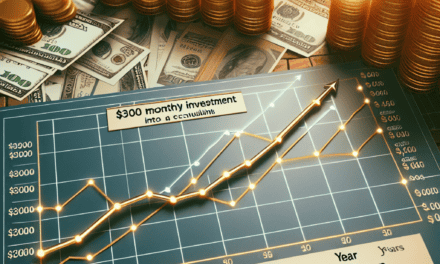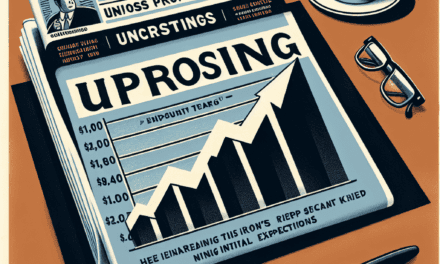“Steady As She Goes: US Stocks Hold Firm Ahead of Key Rate Decision”
Introduction
U.S. stocks maintained their upward trajectory as investors navigated a complex landscape of economic indicators and corporate earnings, all while anticipating the Federal Reserve’s upcoming rate decision. The market’s resilience reflects a cautious optimism, with major indices posting gains amid a backdrop of mixed economic data and geopolitical uncertainties. As the Federal Reserve prepares to announce its latest monetary policy stance, market participants are keenly focused on potential signals regarding the future path of interest rates. This decision is pivotal, as it could influence borrowing costs, consumer spending, and overall economic growth. In this environment, investors are balancing the prospects of continued economic recovery against the risks of inflationary pressures and global economic challenges.
Impact Of Interest Rate Decisions On US Stock Market
The impact of interest rate decisions on the US stock market is a subject of perennial interest to investors, analysts, and policymakers alike. As the Federal Reserve’s rate decision looms, the market’s anticipation is palpable, with US stocks maintaining gains amidst a backdrop of economic uncertainty and investor speculation. Understanding the intricate relationship between interest rates and stock market performance is crucial for comprehending the broader economic landscape.
Interest rates, set by the Federal Reserve, serve as a critical tool for managing economic growth and inflation. When the Federal Reserve adjusts interest rates, it influences borrowing costs for consumers and businesses, thereby affecting spending and investment decisions. A lower interest rate environment typically encourages borrowing and investment, which can stimulate economic growth. Conversely, higher interest rates can dampen economic activity by making borrowing more expensive, thereby curbing spending and investment.
The stock market often reacts to interest rate changes, as these adjustments can significantly impact corporate profits and investor sentiment. When interest rates are low, companies can borrow at reduced costs, potentially leading to increased capital expenditures and expansion efforts. This can result in higher future earnings, which tend to boost stock prices. Additionally, lower interest rates make fixed-income investments like bonds less attractive, prompting investors to seek higher returns in the stock market.
However, the relationship between interest rates and stock market performance is not always straightforward. While lower rates can be beneficial for stocks, they may also signal underlying economic weaknesses that could eventually weigh on corporate earnings. Moreover, the anticipation of rate changes can lead to market volatility, as investors adjust their portfolios in response to expected shifts in monetary policy.
As the Federal Reserve’s rate decision approaches, market participants closely analyze economic indicators such as employment data, inflation rates, and GDP growth to gauge the central bank’s likely course of action. The Fed’s dual mandate of promoting maximum employment and stable prices often guides its decisions, with the central bank striving to balance these objectives in a dynamic economic environment.
In recent months, the US stock market has demonstrated resilience, maintaining gains despite the looming rate decision. This resilience can be attributed to several factors, including robust corporate earnings, strong consumer spending, and a generally positive economic outlook. Nevertheless, investors remain vigilant, aware that unexpected rate hikes or dovish stances could alter market dynamics.
The Federal Reserve’s communication strategy also plays a crucial role in shaping market expectations. By providing forward guidance and transparency regarding its policy intentions, the Fed aims to minimize market disruptions and ensure a smooth transition in monetary policy. This approach helps investors make informed decisions, reducing uncertainty and fostering stability in financial markets.
In conclusion, the impact of interest rate decisions on the US stock market is multifaceted, with both direct and indirect effects on corporate profitability and investor behavior. As the Federal Reserve’s rate decision looms, market participants continue to navigate a complex landscape, balancing optimism with caution. By understanding the interplay between interest rates and stock market performance, investors can better position themselves to capitalize on opportunities and mitigate risks in an ever-evolving economic environment.
Historical Analysis Of US Stocks During Rate Decision Periods
The behavior of U.S. stocks during periods leading up to Federal Reserve rate decisions has long been a subject of interest for investors and analysts alike. Historically, these periods are characterized by heightened market activity and increased volatility, as market participants attempt to anticipate the central bank’s next move. Understanding the historical patterns of stock performance during these times can provide valuable insights into current market dynamics.
In examining past rate decision periods, it becomes evident that U.S. stocks often experience a mix of optimism and caution. Typically, in the weeks leading up to a rate announcement, investors engage in speculative trading based on economic indicators, corporate earnings reports, and statements from Federal Reserve officials. This speculative behavior can lead to fluctuations in stock prices, as market sentiment shifts in response to new information. For instance, if economic data suggests a strengthening economy, investors might anticipate a rate hike, which could initially lead to a sell-off in stocks due to concerns about higher borrowing costs. Conversely, if the data points to economic weakness, the expectation of a rate cut might buoy stock prices as investors foresee lower interest rates stimulating economic activity.
Moreover, the historical context of each rate decision plays a crucial role in shaping market reactions. During periods of economic expansion, the anticipation of rate hikes is often met with mixed reactions. On one hand, higher rates can signal confidence in the economy’s strength, potentially boosting investor sentiment. On the other hand, increased borrowing costs can weigh on corporate profits and consumer spending, leading to concerns about future growth. In contrast, during economic downturns, the prospect of rate cuts is generally welcomed by the market, as lower rates are seen as a tool to spur economic recovery.
Another important factor to consider is the communication strategy of the Federal Reserve. Over the years, the Fed has increasingly emphasized transparency and forward guidance, aiming to reduce uncertainty and provide clearer signals to the market. This approach has helped to moderate some of the volatility traditionally associated with rate decision periods. By clearly articulating its policy intentions and the economic rationale behind them, the Fed can help align market expectations with its policy objectives, thereby reducing the likelihood of abrupt market reactions.
Furthermore, the global economic environment can also influence U.S. stock performance during rate decision periods. In an interconnected world, developments in major economies such as China and the European Union can have significant implications for U.S. monetary policy and, by extension, stock market behavior. For example, if global economic conditions are deteriorating, the Fed might adopt a more accommodative stance, which could support stock prices. Conversely, strong global growth might lead to a more aggressive tightening cycle, potentially exerting downward pressure on stocks.
In conclusion, the historical analysis of U.S. stocks during rate decision periods reveals a complex interplay of factors that influence market behavior. While each period is unique, certain patterns emerge, such as the impact of economic indicators, the Fed’s communication strategy, and global economic conditions. By understanding these dynamics, investors can better navigate the uncertainties associated with rate decisions and make more informed investment decisions. As the next rate decision looms, these historical insights remain as relevant as ever, offering a valuable lens through which to view current market developments.
Key Factors Driving US Stock Gains Amid Rate Uncertainty
In recent weeks, US stocks have demonstrated a remarkable resilience, maintaining gains even as the financial world anticipates the Federal Reserve’s impending rate decision. This period of market stability, amid a backdrop of economic uncertainty, can be attributed to several key factors that have collectively bolstered investor confidence. Understanding these elements provides insight into the current market dynamics and the potential implications of future monetary policy shifts.
Firstly, corporate earnings have played a pivotal role in sustaining stock market gains. Many companies have reported stronger-than-expected quarterly results, which have reassured investors about the underlying health of the economy. This positive earnings season has been characterized by robust revenue growth and improved profit margins across various sectors, including technology, healthcare, and consumer goods. As a result, investor sentiment has been buoyed by the belief that businesses are well-positioned to weather potential economic headwinds, thereby supporting stock valuations.
In addition to corporate performance, economic indicators have also contributed to the market’s resilience. Recent data releases have painted a mixed but generally positive picture of the US economy. For instance, the labor market has continued to show strength, with unemployment rates remaining low and job creation figures exceeding expectations. This has been complemented by steady consumer spending, which remains a critical driver of economic growth. While inflationary pressures persist, they have shown signs of moderating, which has alleviated some concerns about the potential for aggressive monetary tightening.
Moreover, the global economic landscape has provided a supportive backdrop for US stocks. Despite geopolitical tensions and economic challenges in other regions, the US has emerged as a relative safe haven for investors seeking stability. The strength of the US dollar, coupled with the country’s robust economic fundamentals, has attracted foreign investment, further underpinning stock market gains. This influx of capital has helped offset any domestic uncertainties and has reinforced the perception of the US as a reliable investment destination.
However, it is important to acknowledge the looming uncertainty surrounding the Federal Reserve’s rate decision. Market participants are keenly aware that the central bank’s actions will have significant implications for future economic conditions. While the Fed has signaled a cautious approach to rate hikes, the timing and magnitude of any adjustments remain uncertain. Investors are closely monitoring the Fed’s communications for any indications of its policy trajectory, as even subtle shifts in language can have profound effects on market sentiment.
In anticipation of the rate decision, market volatility may increase as investors reassess their positions and adjust their portfolios accordingly. Nonetheless, the current environment suggests that the market’s underlying strength, driven by solid corporate earnings and favorable economic indicators, may provide a buffer against potential disruptions. As such, while the path forward remains uncertain, the resilience of US stocks in the face of rate uncertainty underscores the complex interplay of factors that continue to shape market dynamics.
In conclusion, the sustained gains in US stocks amid looming rate decisions highlight the multifaceted nature of market forces. Corporate earnings, economic indicators, and global investment trends have collectively contributed to a stable market environment, even as investors remain vigilant about future monetary policy shifts. As the Federal Reserve’s decision approaches, the market’s ability to navigate uncertainty will be tested, but the current resilience suggests a cautiously optimistic outlook for the near term.
Investor Sentiment And US Stock Performance Pre-Rate Decision
As the financial markets brace for the Federal Reserve’s impending rate decision, investor sentiment remains cautiously optimistic, reflected in the sustained gains of US stocks. This period of anticipation is marked by a complex interplay of economic indicators, corporate earnings reports, and geopolitical developments, all of which contribute to shaping market expectations. Investors are keenly aware that the Federal Reserve’s decision on interest rates could significantly influence the trajectory of the stock market, making the current environment one of heightened vigilance and strategic positioning.
In recent weeks, US stocks have demonstrated resilience, buoyed by a combination of robust corporate earnings and positive economic data. Major indices, including the S&P 500 and the Dow Jones Industrial Average, have maintained upward momentum, suggesting that investors are, for the moment, confident in the underlying strength of the economy. This confidence is further bolstered by a labor market that continues to exhibit signs of vitality, with unemployment rates remaining low and job creation figures surpassing expectations. Such indicators provide a foundation of stability, encouraging investors to maintain their positions in equities despite the looming uncertainty surrounding interest rates.
However, the specter of the Federal Reserve’s rate decision casts a long shadow over the market. Historically, changes in interest rates have had profound effects on stock valuations, as they influence borrowing costs, consumer spending, and corporate investment. A rate hike, for instance, could lead to increased costs for businesses and consumers alike, potentially dampening economic growth and, by extension, corporate profits. Conversely, a decision to hold rates steady or implement a more dovish policy could be perceived as a signal of continued economic support, thereby sustaining or even enhancing investor confidence.
Amidst this backdrop, market participants are closely monitoring the Federal Reserve’s communications for any hints of its future policy direction. The central bank’s statements and economic projections are scrutinized for insights into its assessment of inflationary pressures, economic growth prospects, and the overall health of the financial system. This analysis is crucial, as it helps investors gauge the likelihood of various rate scenarios and adjust their portfolios accordingly.
In addition to domestic factors, global economic conditions also play a pivotal role in shaping investor sentiment. Trade tensions, geopolitical conflicts, and fluctuations in commodity prices are just a few of the external variables that can influence market dynamics. For instance, ongoing trade negotiations between major economies have the potential to impact global supply chains and economic growth, thereby affecting US stock performance. Similarly, geopolitical developments, such as conflicts in key regions, can lead to volatility in energy prices, which in turn can have ripple effects across various sectors of the stock market.
As the rate decision approaches, investors are advised to remain vigilant and consider a diversified approach to their portfolios. By balancing exposure across different asset classes and sectors, they can mitigate potential risks associated with interest rate fluctuations and other market uncertainties. In conclusion, while US stocks have maintained gains in the lead-up to the Federal Reserve’s rate decision, the market remains in a state of watchful anticipation. The outcome of this decision will undoubtedly have significant implications for investor sentiment and stock performance, underscoring the importance of staying informed and adaptable in an ever-evolving financial landscape.
Sector-Wise Breakdown Of US Stock Gains As Rate Decision Approaches
As the financial markets brace for the Federal Reserve’s impending rate decision, US stocks have managed to maintain their upward trajectory, reflecting a complex interplay of sector-specific dynamics. Investors are keenly observing how different sectors are responding to the current economic environment, characterized by a mix of optimism and caution. This sector-wise breakdown provides a nuanced understanding of the market’s performance as the rate decision looms.
The technology sector, a perennial market leader, continues to exhibit robust gains. Driven by strong earnings reports and sustained demand for digital solutions, tech stocks have been buoyant. Companies specializing in cloud computing, artificial intelligence, and cybersecurity are particularly thriving, as businesses across industries increasingly rely on these technologies to enhance efficiency and security. Moreover, the sector’s resilience is further bolstered by its ability to adapt to changing consumer behaviors and technological advancements, making it a cornerstone of the current market rally.
In contrast, the financial sector is experiencing a more cautious ascent. Banks and financial institutions are closely monitoring the Federal Reserve’s signals, as interest rate changes directly impact their profit margins. While higher rates could potentially increase net interest income, they also pose risks to loan growth and credit quality. Nevertheless, the sector has shown resilience, supported by strong capital positions and diversified revenue streams. Additionally, the ongoing digital transformation within financial services is creating new opportunities for growth, as firms invest in fintech innovations to enhance customer experiences and operational efficiency.
The healthcare sector is another area of interest, demonstrating steady gains amid the broader market rally. With an aging population and increasing demand for innovative treatments, healthcare companies are well-positioned for long-term growth. Pharmaceutical firms, in particular, are benefiting from advancements in biotechnology and personalized medicine, which are driving new drug discoveries and therapies. Furthermore, the sector’s defensive nature makes it an attractive option for investors seeking stability in uncertain times, as healthcare demand remains relatively inelastic regardless of economic conditions.
Meanwhile, the consumer discretionary sector is witnessing a mixed performance. On one hand, companies in the travel and leisure industries are experiencing a resurgence as pandemic-related restrictions ease and consumer confidence improves. On the other hand, retailers are facing challenges due to supply chain disruptions and inflationary pressures, which are impacting profit margins. Despite these headwinds, the sector remains resilient, with e-commerce and digital marketing strategies playing a crucial role in driving sales and customer engagement.
The energy sector is also garnering attention, as fluctuating oil prices and geopolitical tensions influence market dynamics. While traditional energy companies are benefiting from higher commodity prices, there is a growing emphasis on renewable energy investments. This shift is driven by increasing environmental awareness and policy initiatives aimed at reducing carbon emissions. As a result, companies involved in solar, wind, and other clean energy technologies are gaining traction, reflecting a broader transition towards sustainable energy solutions.
In summary, as the Federal Reserve’s rate decision approaches, US stocks are maintaining their gains, supported by sector-specific strengths and challenges. The technology sector continues to lead the charge, while financials, healthcare, consumer discretionary, and energy sectors each present unique opportunities and risks. Investors are navigating this complex landscape with a keen eye on economic indicators and policy developments, underscoring the importance of a diversified approach in managing market uncertainties. As the rate decision looms, the interplay between these sectors will remain a focal point for market participants seeking to capitalize on emerging trends and opportunities.
Expert Predictions On US Stock Trends With Upcoming Rate Decision
As the financial world keenly anticipates the Federal Reserve’s upcoming rate decision, US stocks have managed to maintain their gains, reflecting a complex interplay of investor sentiment and economic indicators. The stock market’s resilience in the face of potential interest rate adjustments underscores the intricate dynamics at play, as market participants weigh the implications of monetary policy on economic growth and corporate profitability. Expert predictions on US stock trends suggest a cautious optimism, with analysts closely monitoring the Federal Reserve’s signals for any shifts in its monetary stance.
In recent weeks, the stock market has demonstrated a remarkable ability to absorb economic data and geopolitical developments, maintaining a steady upward trajectory. This resilience can be attributed to a combination of robust corporate earnings, strong consumer spending, and a labor market that continues to show signs of strength. However, the looming rate decision introduces an element of uncertainty, as investors grapple with the potential impact of higher borrowing costs on economic activity and market valuations.
Transitioning to the Federal Reserve’s role, it is crucial to understand that its decisions on interest rates are pivotal in shaping market expectations. A rate hike, while indicative of confidence in the economy’s strength, could also lead to increased borrowing costs for businesses and consumers, potentially dampening economic growth. Conversely, maintaining current rates or signaling a more dovish approach could provide a boost to market sentiment, encouraging further investment in equities.
Experts are divided on the likely course of action, with some predicting a rate hike as a necessary measure to curb inflationary pressures, while others argue for a more cautious approach given the global economic uncertainties. The Federal Reserve’s dual mandate of promoting maximum employment and stabilizing prices adds another layer of complexity to its decision-making process, as it seeks to balance these sometimes conflicting objectives.
In light of these considerations, market analysts are advising investors to adopt a diversified approach, emphasizing the importance of balancing risk and reward in an uncertain environment. Sectors such as technology and healthcare, which have shown resilience in past rate hike cycles, are being highlighted as potential areas of opportunity. Additionally, dividend-paying stocks and those with strong balance sheets are being recommended as a hedge against potential volatility.
As the rate decision approaches, it is also important to consider the broader economic context. Global supply chain disruptions, geopolitical tensions, and varying recovery rates across different regions all contribute to the complexity of the current market environment. These factors, combined with domestic economic indicators, will likely influence the Federal Reserve’s decision and, by extension, the trajectory of US stocks.
In conclusion, while the upcoming rate decision presents a significant moment for the stock market, the overall outlook remains cautiously optimistic. The ability of US stocks to maintain gains amidst uncertainty reflects a broader confidence in the underlying strength of the economy. However, investors should remain vigilant, staying informed about economic developments and adjusting their strategies accordingly. As the Federal Reserve navigates its path forward, its decisions will undoubtedly play a crucial role in shaping the future landscape of US stock trends.
Strategies For Investors Navigating US Stocks During Rate Decision Times
As the US stock market continues to maintain its gains amidst the anticipation of an impending rate decision, investors find themselves navigating a complex landscape. The Federal Reserve’s decisions on interest rates have historically had significant implications for the stock market, influencing everything from investor sentiment to corporate profitability. In this context, developing effective strategies becomes crucial for investors aiming to optimize their portfolios and mitigate risks.
To begin with, understanding the relationship between interest rates and stock market performance is essential. Generally, when the Federal Reserve raises interest rates, borrowing costs increase, which can lead to reduced consumer spending and business investment. This, in turn, can negatively impact corporate earnings and stock prices. Conversely, lower interest rates tend to stimulate economic activity by making borrowing cheaper, potentially boosting stock market performance. Therefore, investors must closely monitor economic indicators and Federal Reserve communications to anticipate potential rate changes.
In light of this, diversification emerges as a fundamental strategy for investors. By spreading investments across various asset classes, sectors, and geographies, investors can reduce the impact of interest rate fluctuations on their portfolios. For instance, while certain sectors like technology may be more sensitive to rate hikes due to their reliance on borrowing for growth, others like utilities or consumer staples might offer more stability. Thus, a well-diversified portfolio can help cushion against sector-specific volatility.
Moreover, investors should consider the role of fixed-income securities in their strategies. Bonds, particularly those with shorter durations, can provide a hedge against rising interest rates. As rates increase, bond prices typically fall; however, shorter-duration bonds are less sensitive to rate changes, offering a more stable income stream. Additionally, inflation-protected securities can be a prudent choice, as they adjust with inflation, preserving purchasing power in a rising rate environment.
Another critical aspect is maintaining a long-term perspective. While rate decisions can cause short-term market volatility, historical data suggests that the stock market tends to recover and grow over the long term. Investors who remain focused on their long-term financial goals are better positioned to weather temporary market fluctuations. This approach requires discipline and patience, as well as a clear understanding of one’s risk tolerance and investment horizon.
Furthermore, staying informed and adaptable is vital. The financial landscape is continually evolving, and investors must be prepared to adjust their strategies in response to new information. This involves keeping abreast of economic reports, Federal Reserve statements, and global market trends. Engaging with financial advisors or utilizing investment tools and platforms can also provide valuable insights and support in making informed decisions.
In conclusion, as the US stock market maintains its gains with a rate decision looming, investors face the challenge of navigating an uncertain environment. By employing strategies such as diversification, incorporating fixed-income securities, maintaining a long-term perspective, and staying informed, investors can better position themselves to manage risks and capitalize on opportunities. Ultimately, while interest rate decisions are a critical factor in market dynamics, a well-considered and adaptable investment strategy can help investors achieve their financial objectives amidst the complexities of the market.
Q&A
1. **What is the current trend in US stocks?**
US stocks are maintaining gains as investors anticipate the upcoming rate decision.
2. **What is the primary focus of investors currently?**
Investors are focused on the Federal Reserve’s upcoming rate decision.
3. **How are market participants reacting to economic data?**
Market participants are analyzing economic data to gauge the potential impact on the Federal Reserve’s rate decision.
4. **What sectors are leading the gains in the stock market?**
Technology and consumer discretionary sectors are often among those leading gains during such periods, though specifics can vary.
5. **How is the bond market reacting to the anticipated rate decision?**
The bond market may show increased volatility as traders adjust their positions based on expectations for interest rate changes.
6. **What are analysts predicting about the Federal Reserve’s decision?**
Analysts are divided, with some expecting a rate hike and others predicting a pause, depending on recent economic indicators.
7. **How might the rate decision impact future stock market performance?**
The rate decision could influence future stock market performance by affecting borrowing costs, consumer spending, and corporate profits.
Conclusion
U.S. stocks have sustained their upward momentum as investors anticipate the Federal Reserve’s upcoming rate decision. This stability in the market reflects a cautious optimism among traders, who are weighing the potential impacts of monetary policy adjustments on economic growth and corporate earnings. The resilience of stock prices suggests confidence in the underlying strength of the economy, despite uncertainties surrounding interest rates. As the decision approaches, market participants remain vigilant, balancing the prospects of continued economic expansion against the risks of inflationary pressures and tighter financial conditions.





